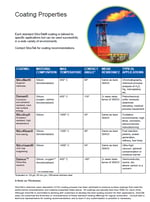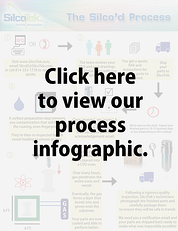
What's the price? We get that question with every order. After issuing the quote customer responses range from "That's it? That's very reasonable." to "Why so much?" In a B2B transaction, the question is not how much but how to rationalize the coating. In the B2B world an unnecessary or unprofitable purchase, no matter how inexpensive is a costly waste of resources, while a costly but profitable purchase is a great deal. So how to rationalize a coating purchase? Let's review the cost and benefit side of the ledger and highlight some factors to consider when evaluating and purchasing our coatings.
The Cost Side:
When comparing coatings or any product, compare the total cost of each option rather than simply comparing the price of a product. Many OEM manufacturers and spec manufacturers see our coatings as a cost; which is fair because they don't realize or capture the inertness, corrosion resistance or anti stick benefit. They see only the added expense, much like they view the added cost a specialty alloy. So let's look at various cost factors to consider when purchasing coatings. Note that costs may reflect positively or negatively on either side of the balance sheet.
First let's discuss the obvious cost, the price of SilcoTek® coatings and what influences pricing. Factors that effect coating pricing are:
-
Size of part: Big parts, higher cost.
-
Number of parts: More parts, lower per-piece price.
-
Complexity of parts: Blind holes, crevices, or highly detailed surfaces impact surface preparation and labor. High complexity, higher price.
-
Special handling needs: Impact engineering time and labor. More time, higher price.
-
Fixturing: Impacts engineering time and labor. More design time, higher price.
-
Surface preparation requirements: Parts requiring special preparation and cleaning will cost more. If parts don't require cleaning and preparation, then the cost will be less.
- Material: Most common is stainless steel. Alloys, glass, ceramics, or aluminum may require special handling or preparation.
Learn more about our coating properties.

That sounds like a lot of work, but thankfully you don't have to do a whole lot! Just tell us about your parts by submitting a quote request and we'll do the rest. If you're not sure about the specifics of your part, no problem, we'll sweat the details.
We quote orders most often in the same day. Common parts like fittings, valves, tubing, regulators, etc. are quoted by a standard price table. Custom parts are quoted by a size chart factored by any special requirements noted above. Curious about the coating process? Check out our silco'd process infographic.

Always compare to the next best available alternative.
So you've got a quote, now it's time to dive in and determine the total cost of the coating and compare costs and benefits of each alternative.
There's always an alternative solution to every purchasing consideration. Options range from:
You can also consider other supply chain efficiency related options like:
Or your could do nothing. Yes! Finally an option I can get my arms around! I can just kick back on the couch and do nothing! That is an option, but you may lose the customer order or ultimately suffer increased costs due to poor yield, or quality. So beware the couch.
Factors to consider when comparing alternatives.
Competitor pricing:
- Make sure you're pricing apples to apples. Develop a concise bid specification to be sure you're pricing the same coating performance with each company. Here's a specification we developed to help customers properly specify our coatings.

- Price the same volume and design. Things change, if you revise the design mid stream bid, notify all bidders to be sure you're getting the same pricing.
Capability:
Be sure each competitor meets your standard for manufacturing delivery/lead time, quality, and support. If you go for "Bob's Discount Coatings" don't be surprised if you end up hating Bob because he messed up your entire delivery plan.
Partnership:
It's an over used term, but it's important, especially in B2B. You're about to insert another company into your manufacturing system. When you have a question or problem, you'll want to pick up the phone and speak directly with an expert, not Bob's answering machine. You also need to be sure they meet your company's quality certification requirements, be it ISO, FDA, NADCAP, SEMI, ASTM, NSF, NACE or other internal specification. Be sure to audit to the specification periodically to be sure manufacturing is aligned with your quality system.
Alternative materials:
We consider our coatings to be another material choice, not just a coating. With that in mind explore all factors when considering alternative materials.
- Strength
- Temperature range
- Durability
- Corrosion resistance to exposed environment.
- Inertness of material
- Hydrophobicity/Oleophobicity
- Machinability/workability
- Sealing capability
For example, PTFE is an inert material but has porosity, temperature, and strength limitations. Be sure to compare and contrast capabilities so you're not surprised by a field failure.

Alternative manufacturing/design solutions
You could coat that part and solve the reactivity or corrosion, or coking problem, or you could redesign the part or system to better deal with the problem. Sometimes a redesign is effective, often the cost and time to redesign a part far exceeds the added coating cost over the life of the project. But it's worth considering
Bundling
Look at all coating opportunities for the year and combine the total expected volume. You may find enough volume to negotiate a price break if you agree to a set minimum volume for the year. This has some risk if you don't meet the expected volume, but can reduce cost in the long run.
On site processing
If volume warrants, you may benefit from an on site processing model. SilcoTek® can engineer systems to coat parts in your facility, significantly reducing overall supply chain cost and time.

Kanban
Just-in-time solutions like kanban can help smooth the supply chain and save on inventory cost. Explore cost savings by implementing more efficient inventory management. SilcoTek® can help by maintaining on site just-in-time delivery for your components.
Other factors:
-
PO cost: Can range from $100 to $200 or more depending on your industry.
-
Shipping: Plan properly and save on costly overnight shipping.
-
Lead time/supply chain reliability: Long lead times or poor supply reliability can shut down your production line. Costing way more than just the price of the coating.
-
Ability to integrate into your purchasing system.
-
Engineering time. How much effort will it take to integrate any of the coating options into my purchasing, quality, and manufacturing system.
-
Customer acceptance vendor qualification. Be sure your customer accepts and recognizes any material or coating selection. They don't care about your cost savings, they care about the performance of your product. Bob's Discount Coatings may not be recognized by your customer or industry as a viable alternative solution. Check first before taking the time to explore any coating option.
-
Reduced use or consumption of time and materials. If it takes your team years to evaluate a coating, or will cost weeks of retooling, you'll need to factor those costs into your evaluation.
-
Number of hours needed to secure the product or product saving. Think low hanging fruit first.
- Measure it. If the savings aren't measurable, they didn't happen. Much like that tree that fell in the woods.
One more factor to think about. Failure to innovate:
A hard concept to quantify but none the less important. Customers keep a close eye on company innovation, just look at Apple. If your products remain unchanged for years, customers will wonder if there's something new on the horizon and begin to look at competitive offerings. No innovation = no customers!
After considering all costs associated with the purchase, tally them in a spread sheet and compare to the benefits and cost savings realized by implementing each alternative.
I've gone on long enough, so I'll leave the benefit considerations for my next blog.
Note: No Bob's were harmed while making this blog post....
Image credit: iconarchive.com





